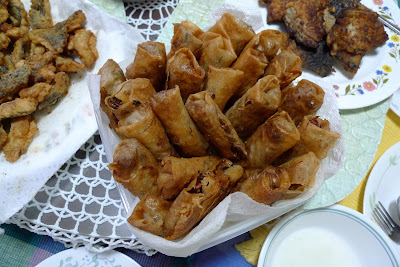




Ever since I was a small child, lenten traditions included a vacation in my father's hometown of Orani Bataan, specifically during Holy Week.
I always looked forward to staying with aunts and cousins, watching the "penitensiya" and the "padugo", attending the church services, doing Bisita Iglesia, following the Good Friday "prusisyon", having a cold "sago at gulaman" free from the friendly neighborhood "caridad".
Admonitions of not laughing too much, keeping our voices low, staying in the house and reading the "Pasyon" were heard but not really obeyed.
I still make it a point to be in Orani come Good Friday every year. This is so I can continue my father's devotion to the "prusisyon" and walk in his footsteps as I follow the "carroza" that he also religiously followed, every Good Friday.
Just like during my younger years, my cousins and I still have not mastered the admonition to keep Good Friday as a quiet and reflective day.
It seems too much like a long awaited reunion, the chance to see each other again, to tell stories and to do the one thing we enjoy most -- sit around the table and eat.
And what feasting we do every Good Friday.
We abstain from meat -- as we should, but we cannot seem to fast.
We console ourselves by saying that we will only eat lunch as our one real meal for the day but what a lunch it always turns out to be.
Not having meat, my cousins pull out all the stops and lay out an array of sea food -- the fattest crabs for which Orani is known for, steamed shrimp, vegetable lumpia, daing na bangus, seafood curry, pancit and the piece de resistance -- the centerpiece of each and every Good Friday lunch ... hingkin!
"Hingkin" is actually a variety of small shark, which reaches a length of about 1 meter, tops. It has a short season, showing up only during March and April -- just around Lent.
These sharks are caught in fishermen's nets, along with the regular catch or sometimes, it shows up in fishponds, getting in through the waterways. It's quite rare and when there is a catch, the lucky "tindera" who has it usually sells it all out within minutes.
In Orani, "hingkin" is cooked as "pesa", a ginger flavored fish soup. I prefer cooking it as a soupy "pospas" -- boiling the fish with some rice to make a watery porridge.
Because sharks have no bones but just cartilage, "hingkin" is fleshy, meaty, all white and very tender and flavorful. The ginger in pesa and pospas removes all traces of "lansa".
The best part of the fish is the liver -- which tastes like foie gras but milder. When you buy "hingkin" at the market, the fish is already cut into slices and when you buy 3 or 4 slices of meaty fish, the seller puts a small piece of liver along with your purchase. Of course the bigger your purchase, the liver also grows from sliver to slice.
Needless to say, that small slice of liver is what everyone hopes to snag during lunch. Being the "bisita" for the day, the out of towner, the "guest of honor" my cousins always try to give me the lion's share -- which of course I never refuse.
"Hingkin" is always eaten with a "sawsawan" of "calamansi and patis". You take your slice of liver, crush it in the "sawsawan" and take a small bite with a very large spoonful of hot rice.
It's almost sinful to have such a great feast when one should really be fasting.

No comments:
Post a Comment